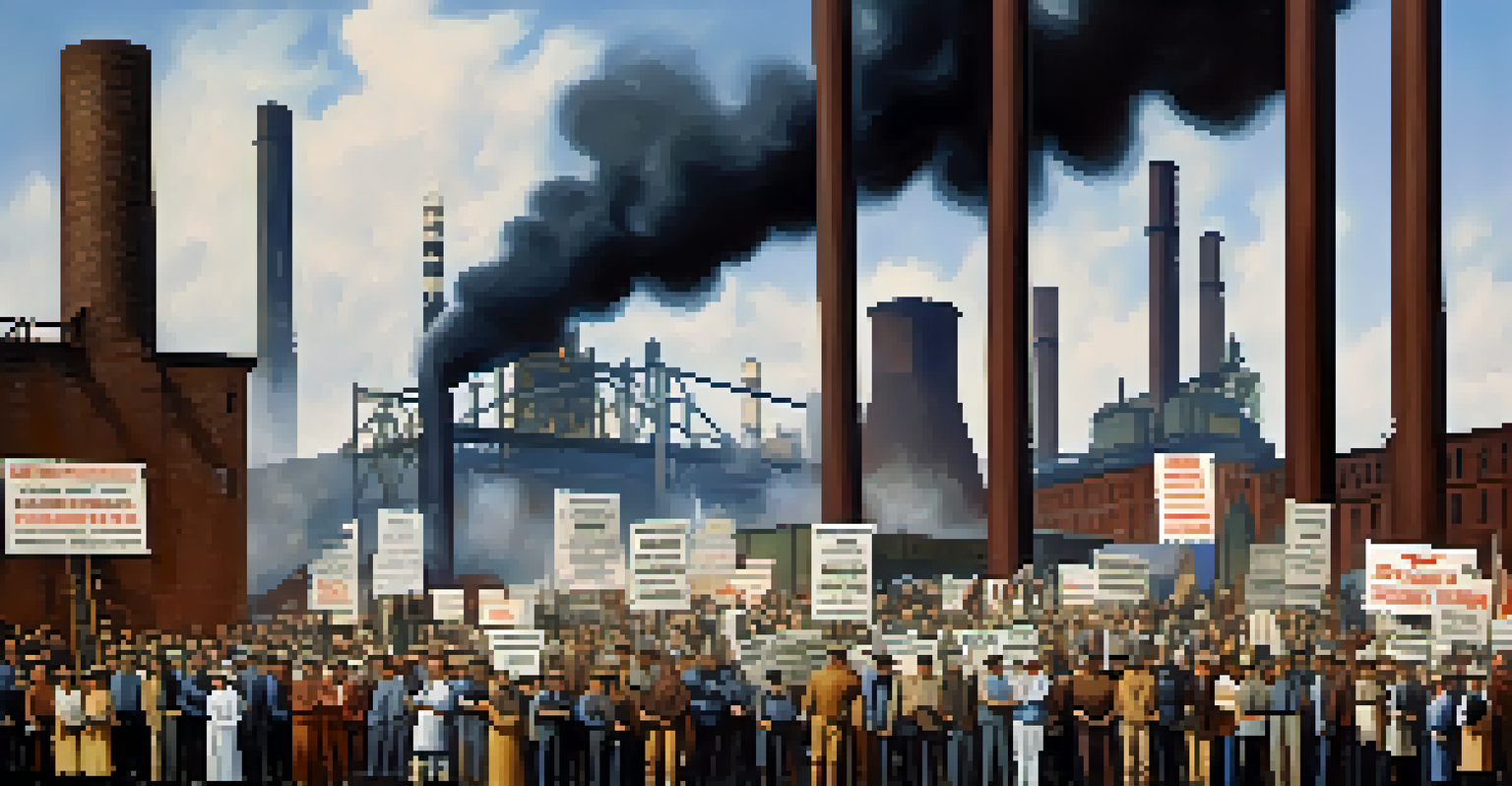Labor Movements in Pittsburgh: The Fight for Steel Workers' Rights

The Birth of Labor Movements in Pittsburgh
Pittsburgh, known as the Steel City, has a rich history of labor movements dating back to the late 19th century. The booming steel industry attracted a large workforce, which soon realized the need for collective bargaining. Workers faced long hours, unsafe conditions, and meager pay, prompting the rise of unions. The formation of organizations like the Amalgamated Association of Iron and Steel Workers marked the beginning of a significant fight for better rights.
The labor movement is a way of life, a way to achieve a better life for all workers.
As these early unions organized, they sought to unify workers across various steel mills. This solidarity was crucial in amplifying their voices and negotiating for improved conditions. Workers began to understand the power of collective action, leading to strikes and protests that would shape the labor landscape. The fight for rights was not just about wages; it was about dignity and respect in the workplace.
The labor movements in Pittsburgh were not without challenges. Strikes often met violent opposition from both employers and law enforcement. However, these struggles laid the groundwork for future advancements in workers' rights, setting a precedent for labor activism across the nation.
Key Strikes That Shaped the Steel Industry
The Homestead Strike of 1892 is one of the most notable events in Pittsburgh's labor history. It was a fierce battle between steelworkers and the Carnegie Steel Company, leading to a violent confrontation. Workers protested against wage cuts and harsh working conditions, and the strike escalated into a national crisis. This pivotal moment highlighted the lengths to which workers would go to fight for their rights.

Similarly, the Pullman Strike of 1894, although originating in Chicago, had ripple effects in Pittsburgh's steel industry. The American Railway Union's support for the striking workers showcased the interconnectedness of labor movements across the country. This solidarity among different trades emphasized the importance of unity in the fight for workers' rights.
Pittsburgh's Labor Movement Origins
The labor movements in Pittsburgh began in the late 19th century, driven by the steel industry's harsh working conditions and the need for collective bargaining.
These strikes not only drew attention to the plight of steelworkers but also garnered national sympathy. They sparked conversations about labor rights and the need for reform, ultimately influencing legislation that aimed to protect workers in various industries.
The Rise of Unions and Their Impact
As the labor movement gained momentum, unions became a powerful force in Pittsburgh. They organized workers, provided a platform for grievances, and negotiated with employers for better conditions. The growth of unions like the United Steelworkers in the mid-20th century marked a significant turning point in labor relations. These organizations played a crucial role in advocating for fair wages, health benefits, and job security.
In union there is strength.
Unions not only fought for immediate gains but also laid the groundwork for long-term improvements in labor laws. They pushed for regulations that ensured safer working environments and fair treatment of workers. This advocacy contributed to the establishment of policies such as the Fair Labor Standards Act, which set standards for minimum wage and overtime pay.
The impact of unions extended beyond the workplace; they became integral to the community. By supporting local initiatives and charities, unions helped improve the quality of life for their members and the surrounding neighborhoods. This sense of community solidarity reinforced the idea that workers' rights were human rights.
Legislation and Labor Rights Advancements
The labor movements in Pittsburgh coincided with significant legislative changes at the national level. The New Deal era in the 1930s brought about reforms that strengthened labor rights. Laws such as the Wagner Act protected workers' rights to organize and bargain collectively. This legislation empowered unions and allowed them to negotiate more effectively with employers.
In the following decades, Pittsburgh continued to see advancements in labor rights, influenced by ongoing activism. The sit-down strikes of the 1930s and 1940s were instrumental in securing better contracts for steelworkers. These actions demonstrated the effectiveness of direct action and negotiation in achieving workers' demands.
Impact of Strikes on Workers' Rights
Key strikes, such as the Homestead and Pullman strikes, not only highlighted workers' struggles but also galvanized national attention towards the need for labor reforms.
However, the fight for labor rights was an ongoing struggle, as workers faced new challenges in the latter half of the 20th century. Economic shifts, globalization, and technological advancements posed threats to job security. Nevertheless, the foundations laid by Pittsburgh's labor movements ensured that workers had a voice in advocating for their rights.
The Role of Women in Labor Movements
Women played a vital role in the labor movements in Pittsburgh, often overlooked in the historical narrative. In the steel industry, women worked in various capacities, from clerical positions to manual labor, contributing significantly to the workforce. They faced unique challenges, including wage disparities and limited opportunities for advancement. Women's involvement in unions and labor activism was crucial in advocating for their rights and pushing for equality.
During World War II, women stepped into roles traditionally held by men, further highlighting their importance in the labor force. This shift not only challenged gender norms but also showcased women's capabilities in demanding better working conditions. Organizations like the Women's Trade Union League were instrumental in rallying support for female workers, advocating for fair treatment and representation.
The contributions of women in Pittsburgh's labor movements laid the groundwork for future generations. Their activism encouraged the inclusion of women's rights in the broader labor agenda, emphasizing that the fight for equality was integral to the labor movement. This legacy continues to inspire women today as they advocate for rights in various industries.
Challenges Faced by Steel Workers Today
While historical labor movements achieved significant victories, steelworkers in Pittsburgh still face challenges today. The decline of the steel industry has led to job losses and economic instability in the region. Many workers are grappling with the consequences of plant closures and the shift towards automation. As a result, the fight for job security and fair wages remains critical.
Additionally, workers today encounter new issues, such as the gig economy and the rise of non-traditional employment. These changes blur the lines of labor rights, making it harder for workers to access benefits and protections. Unions are adapting to these new realities, working to organize workers in evolving industries and advocate for their rights.
Women’s Role in Labor Activism
Women significantly contributed to Pittsburgh's labor movements, advocating for equality and fair treatment amidst wage disparities and limited opportunities.
The resilience of Pittsburgh's steelworkers is evident as they continue to fight for their rights. Through ongoing activism and solidarity, they strive to secure a better future for themselves and their families. The spirit of the labor movements that once defined Pittsburgh lives on, reminding us that the struggle for workers' rights is far from over.
The Future of Labor Movements in Pittsburgh
As we look towards the future, the legacy of labor movements in Pittsburgh serves as both an inspiration and a roadmap. The ongoing fight for workers' rights emphasizes the importance of solidarity and collective action. Today's labor movements are evolving, addressing contemporary issues like climate change, technology, and economic inequality. This adaptability ensures that the spirit of activism continues to thrive in new forms.
The involvement of younger generations in labor activism is crucial for the future of these movements. As new workers enter the labor market, they bring fresh perspectives and innovative ideas. Engaging young people in discussions about workers' rights helps to keep the movement vibrant and relevant. It's important for established unions to mentor and empower these future leaders.

Ultimately, the future of labor movements in Pittsburgh will depend on the ability to adapt to changing dynamics while staying true to their core values. By learning from the past and embracing new challenges, workers can continue to advocate for their rights effectively. The story of Pittsburgh's labor movements is ongoing, and its future remains bright with the promise of a fairer, more equitable workplace for all.